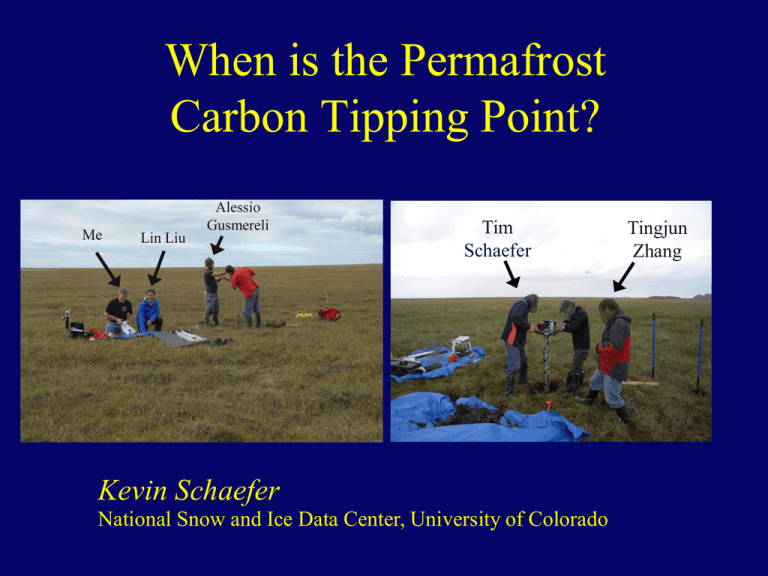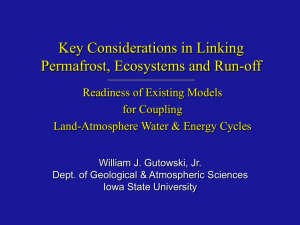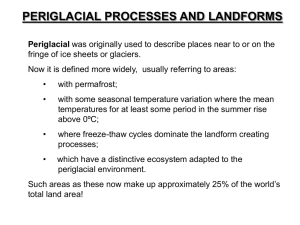Schaefer: Permafrost - University of Colorado Boulder
advertisement

When is the Permafrost Carbon Tipping Point? Me Lin Liu Alessio Gusmereli Tim Schaefer Kevin Schaefer National Snow and Ice Data Center, University of Colorado Tingjun Zhang Permafrost Primer Permafrost: Ground at or below 0°C for at least 2 consecutive years Active Layer: A layer over permafrost that freezes and thaws annually Permafrost Degradation: A decrease in permafrost extent; an increase in active layer thickness. Skiklomanov [2007] Permafrost Classification Permafrost Classification by Area Continuous (>90% of area) Discontinuous (50-90% of area) Sporadic (10-50% of area) Isolated (<10% of area) Brown et al., 1998; Zhang et al., 1999 Permafrost Distribution by Country Permafrost Profile Vegetation Active Layer Permafrost Permafrost Profile Exposed permafrost by river, Siberia [Davis, 2000] Thermokarst, Alaska Cryoturbation • Movement of soil or rock due to repeated freezing and thawing Vegetation Active Layer Permafrost Pleistocene Cryoturbation, France Permafrost Features Frost Heave, Yamal Stone Circles, Svalbard Stone Circles, NW Territories Stripes, Glacier NP Ice Wedges and Polygons 1st Winter Active Layer Frozen 1st Spring Frozen Thawed Permafrost Soil contracts & cracks Polygons, Yena 100th Winter Crack fills with water & freezes 100th Spring Thawed Ice Wedge Polygons, Prudhoe Bay [Zhang, 2009] Ice Lenses and Layers Year 1,000 Year 1 Active Layer Permafrost Capillary suction of water to permafrost Ice Lens Water freezes & expands Ice Lenses Active Layer Permafrost Ice Layer Permafrost is Like Concrete Wickland Schaefer Thermokarst • Thermokarst: subsidence or collapse of ground surface due to melting of ground ice Slope Mountain, Alaska [Schaefer, 2012] Impacts of Degradation Foundation Settling in Chersky Alaska Road Heaves Qinghai-Xizang Highway Bridge Thermokarst in Yakutsk [Skiklomanov, 2005] Impacts of Degradation Coastal Erosion, Alaska Drying lake, Tibet [Zhang, 2007] Rockfall, Matterhorn [Gruber, 2003] Ice-wedge thaw, Alaska [Davis, 2000] Global Carbon Cycle Atmosphere 750 Gt + 3 Gt yr-1 120 119 1.9 1.7 90 88 6 Vegetation 600 Gt Soils 1400 Gt Permafrost 1466 Gt Ocean 38,000 Gt Fossil Fuel 4000 Gt Permafrost Carbon Burial ~1466 Gt C in permafrost [Tarnocai et al., 2009] Deposition (loess, peat, erosion, volcanic) Soil Depth Active Layer Permafrost Horizon Permafrost Permafrost Carbon Mammoth, Siberia 32,000 year old grass, Alaska 30,000 year old roots, Siberia [Zimov et al., 2006] 15,000 year old moss, North Slope [Schaefer , 2012] Permafrost Carbon Feedback Amplification of warming due to release of CO2 and CH4 from thawing permafrost Methane Release from Thawing Permafrost Methane emission Thermokarst Erosion Peat Thaw bulb Permafrost Methane production Dead plant & animal remains Burning methane over a thermokarst lake in Siberia (K. Walter) K. Walter ftkmw1@uaf.edu IPCC A1B Scenario Atmospheric CO2 (ppm) 800 700 600 500 400 300 200 1960 2000 2040 2080 Date (year) 2120 2160 2200 Current Permafrost Active Layer Thickness ALT (cm) Projected Permafrost Degradation HadCM3 (med) Active Layer Thickness ALT (cm) Projected Permafrost Loss Increase in ALT by 2200 (cm) CCSM3 (low) 29% loss HadCM3 (med) 50% loss MIROC3.2 (high) 59% loss Cumulative NEE (Gt C) Permafrost Carbon Tipping Point PCF Tipping Point 2023±4 Date (year) Arctic switches from a sink to a source Permafrost Carbon Flux (Gt C) Cumulative Permafrost Carbon Flux 104±37 Gt 190±64 Gt Date (year) 65±23% of cumulative landppm sink (~160 Gt C) Equivalentglobal to 87±29 Vostok Ice Core Records 80 ppm • CO2 lags behind temperature by 600±400 yr Paleo-Permafrost Carbon Feedback Palaeocene-Eocene Thermal Maximum (PETM) Orbit perturbations trigger Antarctic permafrost thaw [DeConto et al. 2011, in review] PCF and Fossil Fuel Emissions • Both inject old carbon into atmosphere • Both irreversible • A1B scenario: 700 ppm by 2100 • • • 1345 Gt C total emissions 190 Gt C permafrost carbon flux 1157 Gt C fossil fuel emissions • Must reduce fossil fuel emissions by additional 15% or overshoot target climate Conclusions • • • • PCF can explain past climate variability PCF tipping point in mid 2020s PCF is strong: 190±64 Gt C by 2200 Emission reductions must account for PCF • Tellus B paper: Schaefer et al. [2011] Backup Slides The SiBCASA Model Input Weather Boundary Layer Canopy NEE Latent Heat Sensible Heat GPP CO2 Temp Humidity R Temperature Soil Moisture Carbon Snow Permafrost Carbon in SiBCASA Active Layer Active Layer Thickness (ALT) Dmin = max ALT during spinup Permafrost Carbon Pool Dmax = 3 m Permafrost Active Layer Thawed Carbon Permafrost Carbon Pool Soil Carbon Pools Permafrost • 313 Gt C in permafrost carbon pool • 91 Gt C in active layer • 414 Gt C in top 3 m (575 Gt C estimated*) *Tarnocai et al. [2009] Experiment Setup • • • • SiBCASA + ERA40 + A1B scenario Continuous/discontinuous permafrost 1973-2001: “spin up“ 2002-2200: random ERA40 + linear trend • • • MIROC3.2 (high) HadCM3 (med) CCSM3 (low) Estimating Uncertainty • 18 ensemble members • • • 3 warming rates 3 permafrost carbon densities 2 sub-grid permafrost extents • Best estimate: ensemble mean • Uncertainty: ensemble standard deviation IPCC A1B Arctic Temperatures Air Temperature (°C) CCSM3 (low warming) HadCM3 (medium warming) MIRC3.2 (high warming) Average air temperature for permafrost regions Permafrost Area (%) Permafrost Area Loss 169±54 Gt C 203±63 Gt C Date (year) 213±65 Gt C Frozen Ground Extent Permafrost Seasonally Frozen Ground Intermittently Frozen Ground Snow Limit Zhang et al., 2003. EICOP Permafrost covers 24% of land surface in Northern Hemisphere What Drives Permafrost Formation? Atmosphere Vegetation Buffer Layer Snow cover Organic layer Permafrost Geothermal Air Temp (C) Observed Air Temperature (C) 2003-4 Snow Depth (cm) Observed Snow Depth (cm) 2002-3 Soil Depth (m) Observed Soil Temperature (C) 1996-7 Month Soil Temperature (C) Barrow, Alaska Repeated Soil Freeze/Thaw Cycles Shape Permafrost Landscape • Water expands ~9% when it freezes into ice • Frost Heave: rising of ground surface when ground water Freezes • Thaw Settlement: settling of ground surface when ground ice melts • Moisture Movement: soil moisture moves from unfrozen zone to frozen front Permafrost Features Frost Heave, Yamal Stone Circles, Svalbard Stone Circles, NW Territories Stripes, Glacier NP Permafrost Degradation [IPCC, 2007] 4 to 6 C increase in 20th Century 2 to 3 C in last 30 years 1 to 3 °C increase in past several decades >3 °C increase mid-1950s to 1990 0 to 1 °C increase since 1970s Russian Permafrost Temperature Trends Temperature Anomaly (°C) 4 3 2 0.2 m; Trend = +0.78°C/decade 0.4 m; Trend = +0.79°C/decade 0.8 m; Trend = +0.65°C/decade 1.6 m; Trend = +0.55°C/decade 3.2 m; Trend = +0.66°C/decade 1 0 -1 -2 Frauenfeld et al. [2004] Zhang et al. [2005] -3 -4 1950 1955 1960 1965 1970 1975 1980 1985 1990 1995 2000 Year Russian Active Layer Trends Active Layer Depth Anomaly (m) 0.3 1960–1998 Change: +25 cm 0.2 0.1 0 -0.1 -0.2 Frauenfeld et al. [2004] Zhang et al. [2005] -0.3 1955 1960 1965 1970 1975 1980 1985 1990 1995 2000 Year Talik Development • Talik: Unfrozen soil layer above permafrost, but below seasonally frozen surface layer Soil Temperature at 3.2 m in Central Siberia (°C) 1.0 Talik Permafrost 0.5 Soil Temperature (°C) Seasonally frozen ground 0.0 -0.5 -1.0 -1.5 Talik Forms -2.0 -2.5 -3.0 1950 1960 1970 Year 1980 1990 2000 Permafrost Carbon • 1672 Gt C in permafrost [Tarnocai et al., 2009] • 750 Gt C in atmosphere Roots, Siberia [Zimov et al., 2006] Mammoth, Siberia Humus, Siberia [Davis, 2000] Projections of Permafrost Degradation Source Schaefer et al . [2010] Zhang et al . [2008] Saito et al . [2007] Lawrence and Slater [2005] Lawrence et al . [2008] Reduction in Increase in Permafrost Area Active Layer by 2100 (%) Thickness (cm) 4 16-19 60 90 90 19-28 30-80 100-300 500 500 • General Pattern: lose area from the south, increase active layer thickness everywhere Feedbacks to Atmosphere • Energy balance • • • • Snow Albedo Feedback Vegetation Albedo Feedback Sea Ice Loss and Arctic Amplification Bowen ratio seasonality • Trace Gas Feedbacks • • CO2 Fertilization Permafrost Carbon Feedback Net Ecosystem Exchange (NEE) NEE = Respiration - Photosynthesis Enhanced by Permafrost Carbon Feedback Enhanced by CO2 Fertilization • NEE < 0 means net carbon uptake 58±19 Gt C by 2200 is a lot of carbon • 3.5% of permafrost carbon • 26±9 ppm increase comparable Vostok Ice Core (80 ppm) • 13-27% of global land sink • 4±1% of fossil fuel emissions for 700 ppm target Walking Points on Permafrost • Freeze/thaw cycles shape the landscape • Permafrost degradation has already started • Permafrost Carbon Feedback will impact climate and fossil fuel reduction strategies When is the Permafrost Carbon Tipping Point? Kevin Schaefer1, Tingjun Zhang1, Lori Bruhwiler2, Andrew P. Barrett1 1National Snow and Ice Data Center, University of Colorado 2NOAA Earth System Research Laboratory Observed Permafrost Rock Circle Formation Expand out in winter when frozen Drop down in spring when thawed Permafrost Area by Country Permafrost Class by Country Seasonally Frozen Ground Variations of area extent of seasonally frozen ground and snow in the Northern Hemisphere during the winter of 1998/99. Seasonally Frozen Ground Monthly maximum area extent of seasonally frozen ground Seasonally frozen ground is ~65 x 106 km2 or 68% of the land area in the Northern Hemisphere. A Permafrost Model Site-specific factors (albedo, roughness, slope, aspect, snow, soil texture, etc.) Climate/Weather Soil moisture conditions Q* QH QLEQG = 0 Soil thermal properties Thermal diffusion equation Ground temperature regime Geothermal heat flux Modeling Permafrost Atmosphere k = ks() Snow hs(t) Frozen ground = (x,t) C= CFr(x,T) k = kFr (x, T) Boundary condition: Prescribed temperature, or heat flux, or surface energy balance Moving boundary: heat conduction in deforming medium Snow-soil interface: heat conduction with or without phase change C= CFr (x,T) T(Zfr ) = Tf Moving phase plane k = kTh (x, T) Thawed ground C = CTh(x,T) Heat conduction T(Zth ) = T f Permafrost or unfrozen ground Lower Boundary Moving phase plane: heat conduction with or without phase change Boundary condition: prescribed temperature or heat flux Permafrost classification • By area coverage • • • • Continuous (>90% of area) Discontinuous (50-90% of area) Sporadic (10-50% of area) Isolated (<10% of area) • By Location: • • • • Terrestrial Sub-ice Sub-sea Relic • By Coupling with climate: • • Exposed (terrestrial) Submerged (sub-ice, sub-sea, and relic) Frozen Ground Data Products • http://nsidc.org/fgdc • • • • • • • • • • Arctic EASE-Grid Freeze and Thaw Depths, 1901 - 2002 Arctic Soil Freeze/Thaw Status from SMMR and SSM/I, Version 2 Circumpolar Active-Layer Permafrost System (CAPS) Global Annual Freezing and Thawing Indices Modeled Daily Thaw Depth and Frozen Ground Depth Northern Hemisphere EASE-Grid Annual Freezing and Thawing Indices, 1901 - 2002 Northern Hemisphere Seasonal and Intermittently Frozen Ground Areas 1901-2001 Russian Historical Soil Temperature Data Time Series of Active Layer Thickness in the Russian Arctic, 1915-1990 Circumpolar Active-Layer Permafrost System (CAPS) Permafrost Monitoring Permafrost Carbon in SiBCASA Dactive Dthreshold Soil Carbon Pools Dactive Dthreshold Thawed Carbon Permafrost Carbon Pool Permafrost Carbon Pool Dactive = active layer depth Dthreshold = 1973-2001 maximum active layer depth permafrost carbon density is 2% by mass Slow (80%) Metabolic (5%) Structural (15%)







